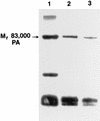Fermentation, purification, and characterization of protective antigen from a recombinant, avirulent strain of Bacillus anthracis
- PMID: 9501438
- PMCID: PMC106355
- DOI: 10.1128/AEM.64.3.982-991.1998
Fermentation, purification, and characterization of protective antigen from a recombinant, avirulent strain of Bacillus anthracis
Abstract
Bacillus anthracis, the etiologic agent for anthrax, produces two bipartite, AB-type exotoxins, edema toxin and lethal toxin. The B subunit of both exotoxins is an M(r) 83,000 protein termed protective antigen (PA). The human anthrax vaccine currently licensed for use in the United States consists primarily of this protein adsorbed onto aluminum oxyhydroxide. This report describes the production of PA from a recombinant, asporogenic, nontoxigenic, and nonencapsulated host strain of B. anthracis and the subsequent purification and characterization of the protein product. Fermentation in a high-tryptone, high-yeast-extract medium under nonlimiting aeration produced 20 to 30 mg of secreted PA per liter. Secreted protease activity under these fermentation conditions was low and was inhibited more than 95% by the addition of EDTA. A purity of 88 to 93% was achieved for PA by diafiltration and anion-exchange chromatography, while greater than 95% final purity was achieved with an additional hydrophobic interaction chromatography step. The purity of the PA product was characterized by reversed-phase high-pressure liquid chromatography, sodium dodecyl sulfate (SDS)-capillary electrophoresis, capillary isoelectric focusing, native gel electrophoresis, and SDS-polyacrylamide gel electrophoresis. The biological activity of the PA, when combined with excess lethal factor in the macrophage cell lysis assay, was comparable to previously reported values.
Figures









Similar articles
-
Production, recovery and immunogenicity of the protective antigen from a recombinant strain of Bacillus anthracis.J Ind Microbiol Biotechnol. 2002 Apr;28(4):232-8. doi: 10.1038/sj/jim/7000239. J Ind Microbiol Biotechnol. 2002. PMID: 11986925
-
Rapid purification of recombinant anthrax-protective antigen under nondenaturing conditions.Biochem Biophys Res Commun. 2001 Aug 10;286(1):6-11. doi: 10.1006/bbrc.2001.5337. Biochem Biophys Res Commun. 2001. PMID: 11485300
-
Production and purification of Bacillus anthracis protective antigen from Escherichia coli.Protein Expr Purif. 2004 Nov;38(1):145-52. doi: 10.1016/j.pep.2004.08.007. Protein Expr Purif. 2004. PMID: 15477093
-
Efficacy of non-toxic deletion mutants of protective antigen from Bacillus anthracis.FEMS Immunol Med Microbiol. 2005 Aug 1;45(2):341-7. doi: 10.1016/j.femsim.2005.05.009. FEMS Immunol Med Microbiol. 2005. PMID: 16019195
-
Molecular basis for improved anthrax vaccines.Adv Drug Deliv Rev. 2005 Jun 17;57(9):1266-92. doi: 10.1016/j.addr.2005.01.028. Epub 2005 Apr 21. Adv Drug Deliv Rev. 2005. PMID: 15935874 Review.
Cited by
-
Recombinant Bacillus anthracis spore proteins enhance protection of mice primed with suboptimal amounts of protective antigen.Vaccine. 2008 Sep 8;26(38):4927-39. doi: 10.1016/j.vaccine.2008.07.015. Epub 2008 Jul 25. Vaccine. 2008. PMID: 18657585 Free PMC article.
-
Enhancement of anthrax lethal toxin cytotoxicity: a subset of monoclonal antibodies against protective antigen increases lethal toxin-mediated killing of murine macrophages.Infect Immun. 2004 Jun;72(6):3276-83. doi: 10.1128/IAI.72.6.3276-3283.2004. Infect Immun. 2004. PMID: 15155630 Free PMC article.
-
Attenuated nontoxinogenic and nonencapsulated recombinant Bacillus anthracis spore vaccines protect against anthrax.Infect Immun. 2000 Aug;68(8):4549-58. doi: 10.1128/IAI.68.8.4549-4558.2000. Infect Immun. 2000. PMID: 10899854 Free PMC article.
-
A Bacillus anthracis strain deleted for six proteases serves as an effective host for production of recombinant proteins.Protein Expr Purif. 2011 Nov;80(1):80-90. doi: 10.1016/j.pep.2011.05.016. Epub 2011 Aug 7. Protein Expr Purif. 2011. PMID: 21827967 Free PMC article.
-
A bivalent protein r-PB, comprising PA and BclA immunodominant regions for comprehensive protection against Bacillus anthracis.Sci Rep. 2018 May 8;8(1):7242. doi: 10.1038/s41598-018-25502-9. Sci Rep. 2018. PMID: 29740033 Free PMC article.
References
-
- Arbigen M V, Bulthuis B A, Schultz J, Crabb D. Fermentation of Bacillus. In: Sonenshein A L, Hoch J A, Losick R, editors. Bacillus subtilis and other gram-positive bacteria. Washington, D.C: American Society for Microbiology; 1993. pp. 871–895.
-
- Bruecker R, Shoseyov O, Doi R H. Multiple active forms of a novel serine protease from Bacillus subtilis. Mol Gen Genet. 1990;221:486–490. - PubMed
-
- Dubois M, Gilles K A, Hamilton T K, Rebers P A, Smith F. Colorimetric method for determination of sugars and related substances. Anal Chem. 1956;28:350–353.
-
- Ezzell J W, Abshire T G. Serum protease cleavage of Bacillus anthracis protective antigen. J Gen Microbiol. 1992;138:543–549. - PubMed
MeSH terms
Substances
LinkOut - more resources
Full Text Sources
Other Literature Sources

